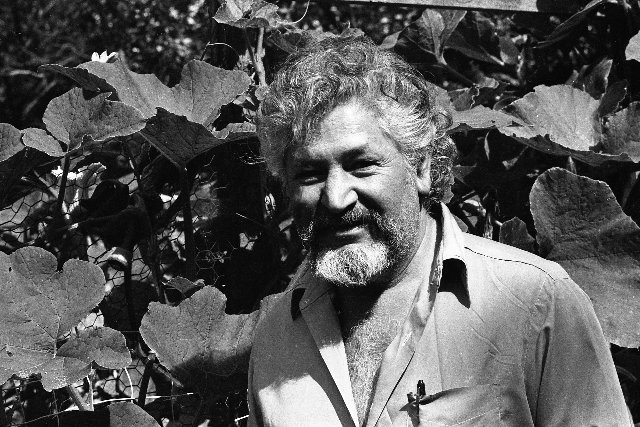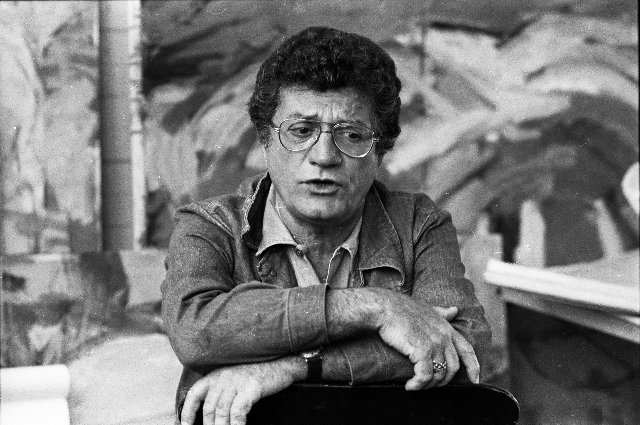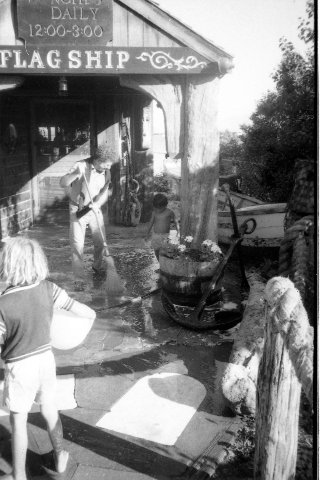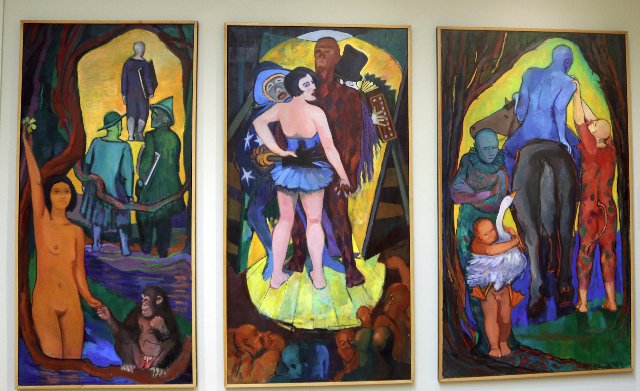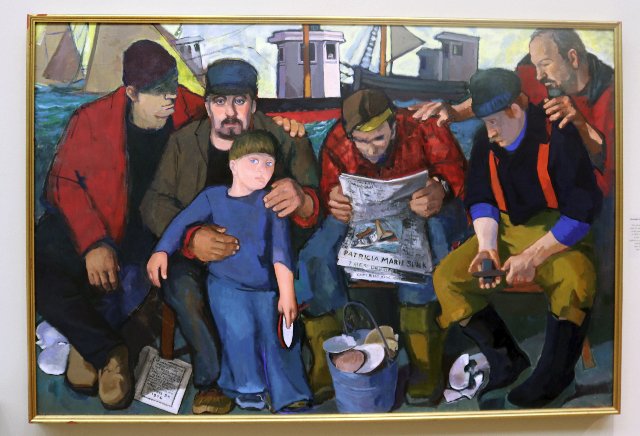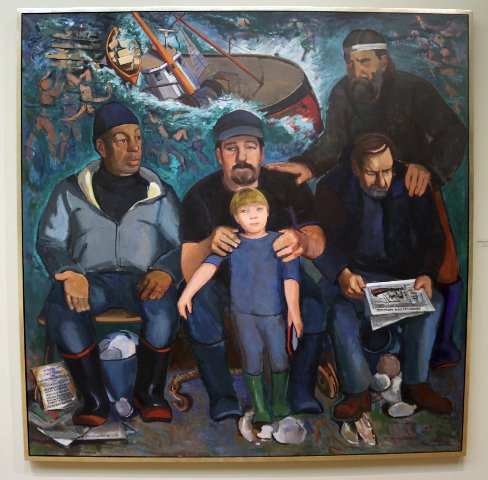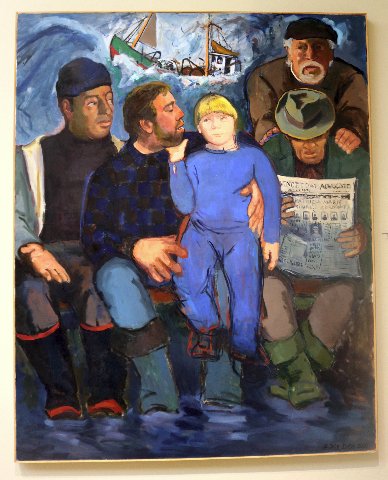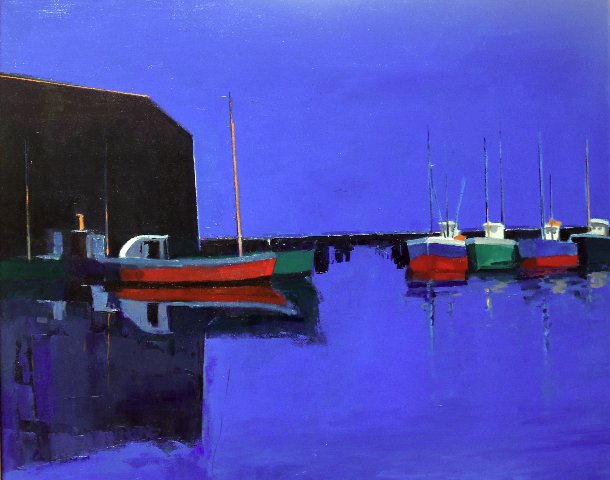Provincetown Artist and Chef Sal Del Deo
Co-founded Ciro and Sal's
By: Charles Giuliano - Nov 15, 2024
We viewed the stunning 2017 retrospective “Salvatore Del Deo: A Storied History” at the Cape Cod Museum of Art in Dennis. In 2023, then 95, he was the subject of national news when there was an attempt to evict the renowned artist and chef from his historic summer Provincetown dune shack.
In the 1980s I first interviewed Sal who, with Ciro Cozzi (1921-2013), started a sandwich shop which expanded into the most renowned of Provincetown’s many storied restaurants, the still running Ciro and Sal’s.
By the 1970s they had parted ways and Del Deo opened his own restaurant Sal’s Place in the East End. I have been regaled with many colorful stories by the artist, Vico Fabbris, who worked for Sal and shared a passion for Italian cuisine. For a time Cozzi expanded the restaurant into a franchise with a second Provincetown restaurant, The Flagship, and a branch in Boston. In addition to expanding, as Peter Manzo revealed in “Ptown: Art, Sex and Money on the Outer Cape” the front of house staff was running a lucrative football pool. When Cozzi bet on the Sunday games losses were routinely subtracted from the till. That’s not good for business. Sal proved to be less flamboyant but more level headed restaurateur.
The Cape Cod Museum’s former director, Edith Tonelli, informed me that Sal, then 92, was in great spirits and enthusiastically worked with her to select paintings that covered the range of his oeuvre from figurative triptychs, to saturated, high chroma landscapes, still life paintings and abstract canvases. He is represented by Berta Walker Gallery in Provincetown.
Over the years, I have seen individual works in exhibitions of the Provincetown Art Association and Museum but viewing them in depth was remarkable.
The artist’s wife, the poet, musician, and arts activist, Josephine Couch Del Deo, passed away at 90. Over a period of 20 years she researched and published “Figures in Landscape, The Life and Times of the American Painter Ross Moffett.”
During the era of WWI Moffett was a part of the generation who joined the artist’s community that was formed around the summer school of Charles Hawthorne. Moffett was a third of the artist’s triumvirate that included Edwin Dickinson and Karl Knaths.
Both Provincetown Art Association and Museum and CCMOA have been crucial in preserving the heritage of generations of Cape Cod’s renowned artists.
When Ciro and Sal settled in Provincetown after WWII they, like many on the GI Bill, came to study with famous teachers. They enrolled in the school of Henry Hensche. He had been an assistant to Hawthorne and continued in the tradition of plein air painting with saturated color and emphasis on the play of natural light. They pursued a conservative, naturalistic form of modernism compared to the radical approach of Hans Hofmann who attracted nascent abstract expressionists to his New York and Provincetown classes.
That influence of Hensche is richly evident in the landscapes of Del Deo the surfaces of canvases are flatter, more abstract, and explode with saturated color. Here the famed Cape Light has been juiced up with riveting intensity.
Particularly striking is a painting of fishing boats tied up to the town dock. The silhouette of a warehouse anchors one end. There are accents of color in the patterns of several boats parallel to the picture plane. Both sea and sky have been flattened into an electric expanse of intense cobalt blue. There are several typically P’Town distant views of flat, parallel stacks of sand. sea and sky.
Del Deo is a part of the long tradition of artists, who remained “true to nature” as John Ruskin stated, but played along the evocative cusp of non objective painting. What intrigues about the work is pushing the limits of site specific, plein air painting which have been finished and intensified in the studio. Tonelli described it as abstract realism.
Early on Sal did odd jobs to pay the rent and one summer went to sea with a scallop boat. It’s that experience which resonates in the poignant triptych “Homage to the Patricia Marie,” It memorializes the sinking, in 1976, of the scallop boat of that name off Eastham. Seven men were lost.
The central figure in the three panels is a boy looking straight out at us. There is pain and loss in his expression. While staring at the viewer he appears to be looking into a beyond that will comprise a future without his dad.
The space of the panels is compressed by a cluster of several fishermen. One whets his scallop shucking knife. Another is huddled over a newspaper that reports the disaster at sea. In a panel we see the boat sinking in an imagined background with sailors foundering in pounding surf.
The exhibition synched with the artist being given the museum’s annual MUSE award for outstanding contributions to the artistic community.
Sal Del Deo
August, 1982
Charles Giuliano When did you meet Karl Knaths?
Sal Del Deo In 1937 I was a student at Vesper George School of Art (St. Botolph Street, Boston). During lunch I would walk to Newbury Street and visit galleries. I saw a Knaths at Boris Mirski Gallery. I was impressed by it. The following year I came to Provincetown. As a student I wrote to Knaths and he answered inviting me to his studio. I later learned that he frequently did this with young artists who admired his work. There were weekly invitations for certain people to come see his latest work. There was always something to look forward to. Even though along in years he was always interested to listen to someone else’s point of view. He was a very humble guy.
He was reclusive but when he knew you he was friendly and jovial. He loved having young people around. He woke up early, painted, and then took a walk in the afternoon. He did his creative work around 7 A.M. He would come by my restaurant sit on the patio and chat. He was reclusive but had close friends.
CG Who were they?
SDD Jim Forsberg and his then wife, Joan Wye. They could read German. They spent the winter translating reading great works in German.
CG In the Archives of American Art there are translations of Mondrian, Kandinsky and Malevich (from German).
SDD He was of German ancestry growing up in Wisconsin. He could read German but not that well. But Joan knew it and they struggled through. His sister-in-law, the artist Agnes Weinrich (1873-1946), figures prominently in this narrative. It’s too bad you weren’t here earlier as there was a wonderful show of her work at the Heritage Museum. They own a few small woodcuts.
Agnes was a great influence. She and Helen, Knaths’ wife, spent time in Paris, Munich and Berlin. It’s where the action was. He never left the States. Agnes opened his eyes to Cubism while her sister Helen was a musician.
CG While a student at the school of the Art Institute of Chicago he was employed as a guard for the touring Armory Show. So he saw Cubism (Duchamp) before he came to Provincetown.
SDD She studied with the cubist Albert Gleizes and knew the futurist Gino Severini. He was a major influence on a lot of Provincetown painters. He wrote prolifically and took on students. He worked in a neo cubist manner.
CG Did you know Agnes?
SDD She died before I came here. Karl thought highly of her as a painter.
CG I understand that you were with him when he died.
SDD I was with him the day before he died. When he was pronounced dead I rushed to his studio to assure that everything was there. There were exquisite works that related back to his early subjects.
CG Do you know the self portrait that Nat Halper owns?
SDD Yes, but it’s not by Knaths. It was painted by his friend Ross Moffett.
CG Nat Halper said that several years before he died Knaths asked him about the Milton Avery estate. Halper concluded that he was concerned about his health.
SDD He had bad attacks of kidney stones. I was with him at the hospital on a couple of occasions. We had long discussions about his estate. There was a collector, Emil Arnold, who bought from him and donated to museums as tax write-offs. Karl was under contract to Rosenberg but could sell anything that they turned back.
CG They were not his best works.
SDD I wouldn’t say that but Rosenberg didn’t think they were his best paintings. The story of the estate is fascinating but makes me sad. This guy Arnold told him to put the work in a bank. They would handle it and take care of Helen. You won’t have to worry about the financial end of it. I cautioned him not to do that. I spoke with people at the bank (Ken Demaris, Cape Cod Bank and Trust) and I was not impressed by their knowledge of art. They had no interest in the preservation of the paintings. After he died I was vindicated when they had a show of his work at the bank. They had taken everything from Rosenberg Gallery and had it all there.
CG Do you recall what was there?
SDD There was a lot there but not the best work. There were the big paintings of “Moby Dick” and “Ishmael.” One of the best works was a still life that I got them to donate to PAAM. I also got the “Deer” which is in the Heritage Museum. Actually, Mrs. Knaths gave the still life to PAAM.
CG There are no dates on “Moby Dick” and “Ishmael.”
SDD I think they’re from the 1940s.
CG How many works were in the bank? A hundred?
SDD Not that many. I wouldn’t chance a guess. There were about 20 works in the bank’s show. What appalled me is that they were all over the bank on cheap easels. They had large cardboard labels tacked to the canvases. I was so angry I took them all off. The bank manager came to me and said “What are you doing?” I said “This is a disgrace.” He told me to come to his office. We talked and he asked “What should we have done.” (The bank served as sole executor with nobody from the art world to advise them.)
I told them that they had no right to treat the work in this manner. “If it were jewelry you would have it appraised and properly protected,” I said, “If you are going to be executors of an artist’s estate you need to retain consultants in order to do things properly.”
CG Are all the paintings gone?
SDD Yes because they got rid of them.
CG The independent dealer and collector, Ed Shein, bought in bulk from the bank. Then immediately met with Jim and Jean Young of Woodstock, New York who bought a number of works from him. They made a serious investment in Knaths and acquired interesting pieces. Including, a portfolio of early abstract monotypes, circa 1919, with about half signed Otto Knaths his birth name. Reggie Cabral may have acquired sketch books and drawings. The bank was pulling pages from sketch books and giving them estate stamps. You see them show up at Provincetown auctions.
Karl was working on a book (“Ornament of Glory”) that he never published. I read it. He had a couple of versions in sketch books. Ferol (Sibley Warthen) could help because she learned his system.
CG She is now 92 and it is difficult to get the specifics.
(There was the exhibition Ornament & Glory : theme and theory in the work of Karl Knaths : October 9-November 21, 1982, Edith C. Blum Art Institute, Milton and Sally Avery Center for the Arts, the Bard College Center, Annandale-on-Hudson, New York. The catalogue included a version of his text. Over the years a number of his artist friends read and suggested edits.)
Why didn’t you learn his system?
SDD By then I was a mature artist and it would have entailed orchestrations of color.
CG Did he discuss with you the grid that he used?
SDD I learned a lot from Karl including the orchestration of a color scheme in a painting. He talked a lot about the picture plane. He was very tough on other painters. He would take down a book of Old Masters and go through it with me. He would identify works which he thought were successful as well as ones that were not; which ones violated the picture plane with confusion between two and three dimensional space. That was always very exciting for me.
CG There are notebooks in the Archives of American art in which he would paste a reproduction of a painting then write comments around it.
SDD Those are the notebooks which I recall from the bank vault. When he was alive he let me borrow them. There were a lot of things that he did which were similar to Klee’s “Pedagogical Sketchbook.”
CG Did he plan to publish that critical analysis?
SDD Mira an elderly lady friend of Ferol’s planned to publish them.
Self Portrait with Sunflowers courtesy of Provincetown Art Association and Museum
CG Did you ever buy his work?
SDD He gave me some things but I didn’t think that way. I own a restaurant which is open during the summer. Overall we live frugally. We are not wealthy by any means. We were here as Ciro and Sal’s for 20 years but split up in 1961. Ciro still owns Ciro and Sal’s and has a branch in Boston.
CG Why did you split?
SDD For many reasons. I thought I wanted to get out of the restaurant business. That just lasted for two years. I did construction work but couldn’t make ends meet. I took over this place and after three years had a chance to buy it at a very good rate. Some friends helped. That was 20 years ago. You couldn’t do it today, not by a long shot. The season is short but I wouldn’t want it any longer. That’s the way I like it. I no longer have to work behind the stove so I have the summer off.
Ciro and I were art students. He had a scholarship to Art Students League in New York where he studied with Mahonri Young (1877-1957, a social realist painter and sculptor). Later he trained as a sculptor with Picciarelli and studied fresco technique with Jean Charlot (1898-1979). We came here to study with Henry Hensche (1899-1992). It was 1946 when we studied with him.
CG Hofmann was here and why didn’t you study with him?
SDD I wasn’t that interested in the modern approach. When we came in the late 1940s Provincetown was very alive. There were a number of galleries, prominent New York galleries with summer branches like Samuel Kootz and Virginia Zabriski. There was the Saltpeter Gallery. Overall, there were at least a half dozen New York based galleries as well as the local ones.
I’ve been here long enough to know that the art scene is cyclical. There were great artists here: Karl Knaths, Edwin Dickinson, Ross Moffett and Hans Hofmann. When they passed a new cycle started with a lull in between.
It’s just beginning to come back again with Long Point in Provincetown and Cherry Stone Gallery in Wellfleet. These galleries show artists of national stature.
CG What attracted you to Karl Knaths?
SDD His use of color which I’m interested in. I always thought he was a great colorist. It was rather unique at the time because it was a deviation from local color. He told me, however, that his color was based on nature. We had a marvelous show of his work at the Art Association. I wish you had seen it, one of the best shows ever. Do you have the Charles Eaton book Karl Knaths Five Decades of Painting.
CG Yes.
SDD He’s the poet in residence at Chapel Hill in North Carolina. They used to have a house in Connecticut and came here in the summer. They have a dozen or so works that they bought from him. He’s in his 60’s a gracious man and supporter of Karl.
CG Was he prolific? There seems to be a lot of work floating around.
SDD He was diligent working every day of his life with no deviation from his schedule.
They had no children or family life. He went to bed after supper and was up at the crack of dawn. He loved any excuse to go out. We would go to galleries together.
He loved to talk about baseball and had been a decent player in his youth. I asked if he played and he said “Third base.” He was a very human kind of guy which was what I loved about him.
When he first came here there were very few artists around, Dickinson and Moffett.
CG Did you know Moffett?
SDD Very well. My wife is writing his biography.
(Figures in a Landscape: The Life and Times of the American Painter, Ross Moffett, 1888-1971 Limited Edition Hardcover – January 1, 1994 by Josephine Couch Del Deo (Author), Ross Moffett, and Ross Moffett 1889-1971, January 1, 1975 by Josephine Couch Del Deo)
CG I would love to see some of that material.
SDD I doubt that she will show it to you because she’s working on it. She has a great deal of stuff. She has written something about Dickinson as well. Dickinson, Moffett and Knaths represented the modern jury for the Art Association when there was a big split.
(At the time I asked Bob Brown the Boston branch director for Archives of American Art about the Moffett material. He said it was on extended loan to Mrs. Del Deo. The AAA branch later closed and since then it has been ever more difficult to deal with them. I even had a lot of trouble gaining access to files I donated to them. They are plagued with budget and staff cuts.)
CG Can I talk to her?
SDD She’s not well.
There’s something else I want to say about Karl. In the early stages he was very opposed to the war in Vietnam as were my wife and I. One of the first petitions against the war was created by artists. It was published in the New York Times. Karl and Helen were listed as were my wife and I. There was a protest in August, 1962 against America and nuclear bombing of Hiroshima and Nagasaki. There was a published photo of Karl and Helen walking through Provincetown denounced as traitors. That brought us together with shared political views. Until the day he died Karl was a tremendous spirit.
CG Did he discuss (Emanuel) Swedenborg with you?
SDD He gave me some things to read. Did you see the little book on Knaths that Duncan Phillips published? Of course Phillips had the largest collection of his work.
CG About his philosophy?
SDD He quoted from Swedenborg The Book of Psalms. He also read the Bible as did his friends Moffett and Dickinson. Each of them had great knowledge of The Bible. Karl and Moffett came from the Mid West and Dickinson from upstate New York.
CG What did he tell you about Swedenborg?
SDD I didn’t understand any of it other than as a pantheistic appreciation of life which I share. Karl was raised Catholic.
CG Did you hear him lecture?
SDD Yes, at the Fine Arts Work Center. He cut through the crap. When there was a lot of double talk in a discussion he would say “Let’s cut all the baloney and get down to the facts.” He was a very matter of fact kind of guy.
CG How did you get into the restaurant business?
SDD As an art student you learn to fend for yourself. It turned out to be something I enjoyed doing and close to painting.
CG Karl was a panelist in Forum ’49.
SDD I recall one at a gallery founded by Weldon Kees. He was an avant-garde poet. He and another poet, Cecil Hemley, started a gallery here. (Gallery 200) It was the first to show a Jackson Pollock drip painting. That was in 1949, just up the street from here.
He lived here early on when he was struggling before the move to the Hamptons. The studio he lived and worked in was bought by Franz Kline. It’s a famous place just up the street from here.
CG You and Ciro worked together?
SDD He had a bunch of kids and there was the chance to buy a house very cheap. He said “How the hell are we going to stay here in the winter and support ourselves?” It was a wonderful life, so beautiful here. There wasn’t a crowd. It was a painter’s paradise.
CG One hears that the fishermen were tolerant and kept to themselves.
SDD They are simplistic in their needs. Their vessels are ship shape and their homes are the same. They tolerated the artists and gays. In the beginning it was like a small European village.
Karl was proud of how little it took for him to live here in the winter. The fishermen on the docks gave us fish.
CG Was he poor?
SDD In the beginning yes. When I knew him he was under contract to Rosenberg Gallery but it took many years to reach that point. I have no idea what the estate is worth. His wife had relatives in Wisconsin who were beneficiaries. I met them when they came here from Wisconsin. When I saw paintings in the bank vault they were priced from $3,000 to $12,000.
(The Kaths will was divided in three. The Art Institute of Chicago, where he trained was willed a third. Another third went to the Phillips Collection in Washington, D.C. in appreciation for all that Duncan Phillips did for him. The final third went to their heirs.)
CG So you think that “Moby Dick” sold for $12,000?
SDD It was very large 8×4’ on masonite. I don’t think he sold it and the painting went into the estate. It was over the bank president’s desk when I saw it.
CG So Knaths never made a lot of money.
SDD He was frugal but never rich. They were modest people. We went clamming together so he had his bucket of clams, a glass of beer, and occasionally wine and that was it.
CG Did he say why he didn’t travel other than to New York and D.C.?
SNN On a number of occasions I asked him about that and he said that it just didn’t interest him. I don’t know why he never went to Europe because he was very excited about what Agnes told him. I would say “I’m going to Italy would you like to come with me?” But he wasn’t interested by then he was too old.
CG You can see a change in the works of the 1960s. They are less structured and have more high key color.
SDD I think he flirted with the ideas of abstract expressionism but never fell in with them.
CG Did he discuss Hofmann?
SDD Yeah.
CG You smile. He didn’t think much of him.
SDD There, you said it.
CG We’ve talked about cycles.
SDD Hensche took over the Hawthorne tradition and ran a very successful school, which Ciro and I studied in. Dickinson was here as a part of the Hawthorne tradition.
CG Dickinson was close to Karl.
SDD Not really. He was linked to Hawthorne but was a friend of Karl and developed a great respect for him. He called him Otto because he knew him well. Very few people called Knaths Otto.
CG By the time Hofmann arrived Knaths, Dickinson and Moffett were the Old Masters of Provincetown.
SDD There had been a split. On one hand was abstract expressionism headed by Hofmann. Then there was modernism derived from cubism which Knaths represented.
CG You would think that Hofmann and Knaths shared commonality.
SDD They respected each other. Karl never downgraded anybody. He liked something or he didn’t. He didn’t care for Hofmann’s color which he felt wasn’t orchestrated.
CG Do you know anything about the Knaths grids?
SDD You mean (Jay Hambidge’s) Dynamic Symmetry? Moffett and Knaths knew it very well. I’ve been trying to read it. He was the great exponent of the Golden Section. Everyone in the 1920s was using it but I don’t see why it’s necessary. The selectivity of the eye can put everything in place. Karl gridded off his pictures.
In general, Karl was tough on other artists but he liked Nicolas de Stael (1914-1955) and Milton Avery. Did you know him?
SDD Very well. Avery was quiet but urbane. Knaths was also quiet but rustic.
CG Did he have a sense of humor?
SDD He was great. Underneath I suspected was a really lusty soul. He had a lusty appetite. His wife was older and that’s where he toned down.
CG Did he have students or assistants?
SDD They had a housekeeper who cooked. She stayed on after Karl died taking care of Helen. There was this kid, Bob Johnson, a student who stayed with him for a number of years. He helped and stretched canvases. I think he’s now in Virginia or North Carolina. Bernie Beckmann also did odd jobs for Karl. There was another kid who helped.
CG He was under contract to Rosenberg and seemed to have steady income.
SDD Yes, for the last 20 years of his life. He was having success winning first prize at the Carnegie as well as The Met. He had paintings in major museums.


